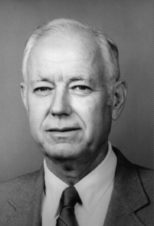Woodrow Wilson "Woody" Bledsoe (November 12, 1921 – October 4, 1995) was an American mathematician, computer scientist, and prominent educator. He is one of the founders of artificial intelligence (AI), making early contributions in pattern recognition,[1] facial recognition,[2] and automated theorem proving.[3][4][5][6] He continued to make significant contributions to AI throughout his long career. One of his influences was Frank Rosenblatt.[7]
Woodrow Wilson Bledsoe | |
|---|---|
 | |
| Born | November 12, 1921 |
| Died | October 4, 1995 (aged 73) |
| Alma mater | University of California, Berkeley |
| Spouse | Virginia (née Norgaard) |
| Children | 4 |
| Awards |
|
| Scientific career | |
| Thesis | Separative Measures for Topological Spaces (1953) |
| Doctoral advisor | Anthony Perry Morse |
| Doctoral students | Robert S. Boyer |
Beginning in 1966, he worked at the department of mathematics and computer science of the University of Texas at Austin, holding the Peter O'Donnell Jr. Centennial Chair in Computing Science starting in 1987.[8]: 723
Bledsoe joined the Church of Jesus Christ of Latter-day Saints as an adult, and served in the church as a bishop, counselor to the stake presidency, and stake patriarch. He also served as a leader in the Boy Scouts of America.[9][10] Bledsoe died on October 4, 1995, of amyotrophic lateral sclerosis, more commonly known as ALS or Lou Gehrig's disease.
Works
editThe n-tuple method (1959) was an early method for learning a pattern recognition program. The basic method is illustrated by the problem of recognizing 36 alphanumerical characters (0-9, a-z).[11]
Let the input be a 10x15 binary image. It is equivalent to a single string with 150 binary letters. Now, randomly partition the 150 binary pixels into 75 pairs. Each pair has 4 possibilities: 00, 01, 10, 11. Now we will define a 300x36 binary matrix as follows:
Let represent the 00-state of the first pair, and similarly for the others. We have 300 such states, each represented in a row. The 36 columns each correspond to one alphanumerical character. The entire binary matrix is arranged as follows: The pattern recognizer is defined by the binary matrix. It is trained by firstsetting all entries to zero, then it is presented with several binary images of each alphanumerical character. For each image, the corresponding entries in the matrix are set to one, and the other entries are unchanged. This is an example of machine learning.
After the training the recognizer, it can be used to recognize new images. First compute the new image's corresponding column vector, then take the dot-product with each column of the binary matrix. The column with the highest dot-product is outputted as the most likely character.
Further reading
edit- Boyer, Anne Olivia; Boyer, Robert S. (1991). "A Biographical Sketch of W. W. Bledsoe". In Boyer, Robert S. (ed.). Automated Reasoning: Essays in Honor of Woody Bledsoe. Kluwer Academic Publishers Group. pp. 1–29. CiteSeerX 10.1.1.57.3396. ISBN 9780792314097.
Selected publications
edit- W.W. Bledsoe (1977). "Non-Resolution Theorem Proving". Artificial Intelligence. 9: 1–35. CiteSeerX 10.1.1.455.6139. doi:10.1016/0004-3702(77)90012-1.
- W.W. Bledsoe; I. Browning (1959). "Pattern Recognition and Reading by Machine". Papers Presented at the December 1–3, 1959, Eastern Joint IRE-AIEE-ACM Computer Conference. IRE-AIEE-ACM '59 (Eastern): 225–232. doi:10.1145/1460299.1460326. S2CID 15672245.
- Woody Bledsoe (1986). "I Had a Dream: AAAI Presidential Address, 19 August 1985". AI Magazine. 7 (1): 57–61.
References
edit- ^ W.W. Bledsoe (1966). "Some Results on Multicategory Pattern Recognition". J. ACM. 13 (2): 304–316. doi:10.1145/321328.321340. S2CID 17150326.
- ^ Raviv, Shaun. "The Secret History of Facial Recognition". Wired. ISSN 1059-1028. Retrieved August 31, 2023.
- ^ W.W. Bledsoe (1971). "Splitting and Reduction Heuristics in Automatic Theorem Proving" (PDF). Artif. Intell. 2 (1): 55–77. doi:10.1016/0004-3702(71)90004-x.
- ^ W.W. Bledsoe (September 1975). "A New Method for Proving Certain Presburger Formulas". Proc. IJCAI (PDF). pp. 15–21.
- ^ W.W. Bledsoe (1977). "Non-Resolution Theorem Proving". Artificial Intelligence. 9: 1–35. CiteSeerX 10.1.1.455.6139. doi:10.1016/0004-3702(77)90012-1. — Preceding technical report ATP29 (Sep.1975)
- ^ W.W. Bledsoe and Kenneth Kunen and Robert E. Shostak (1985). "Completeness Results for Inequality Provers". Artif. Intell. 27 (3): 255–288. doi:10.1016/0004-3702(85)90015-3. — Preceding technical report ATP65 (1983)
- ^ McCorduck, Pamela (2018). Machines who think: a personal inquiry into the history and prospects of artificial intelligence. An A K Peters book. Boca Raton London New York: CRC Press. p. 106. ISBN 978-1-56881-205-2.
- ^ Jean-Louis Lassez; Gordon Plotkin, eds. (1991). Computational Logic — Essays in Honor of Alan Robinson. Cambridge/MA: MIT Press. ISBN 978-0-262-12156-9.
- ^ Memorial Resolution – Woodrow W. Bledsoe
- ^ "UT science pioneer 'Woody' Bledsoe dies". Austin American-Statesman. October 6, 1995. Retrieved March 13, 2013.
- ^ Bledsoe, W. W.; Browning, I. (1959). "Pattern recognition and reading by machine". Papers presented at the December 1-3, 1959, eastern joint IRE-AIEE-ACM computer conference on - IRE-AIEE-ACM '59 (Eastern). ACM Press. pp. 225–232. doi:10.1145/1460299.1460326. ISBN 978-1-4503-7868-0. S2CID 15672245.
External links
edit- Papers and program printouts pertaining to Bledsoe's facial recognition algorithm of the 1960s
- Michael Ballantyne, Robert S. Boyer and Larry Hines. "Woody Bledsoe: His Life and Legacy" AI Magazine, Vol. 17. No. 1, pp. 7–20, Spring 1996, American Association for Artificial Intelligence.
- Woody Bledsoe at DBLP Bibliography Server
- W.W. Bledsoe at the chess programming wiki